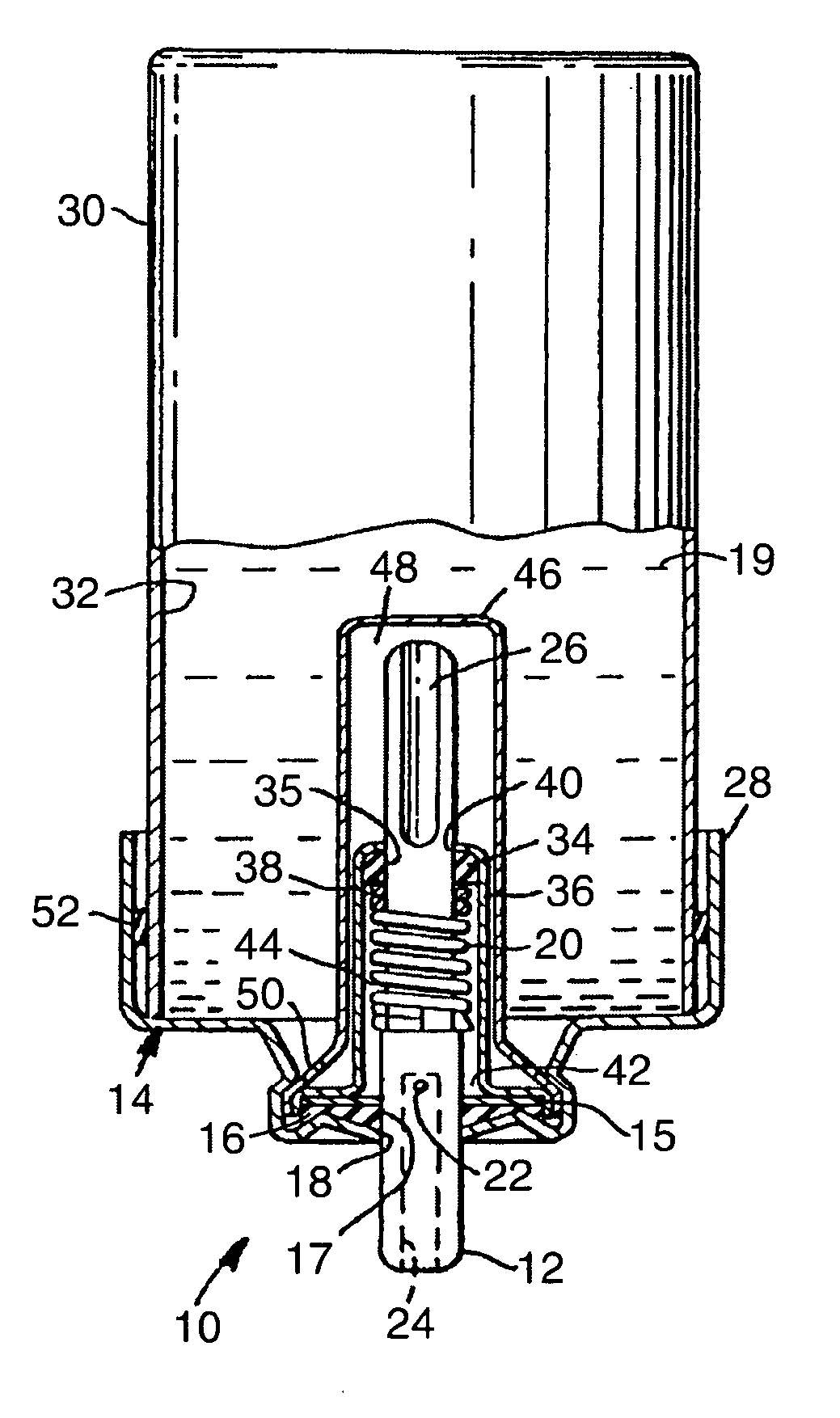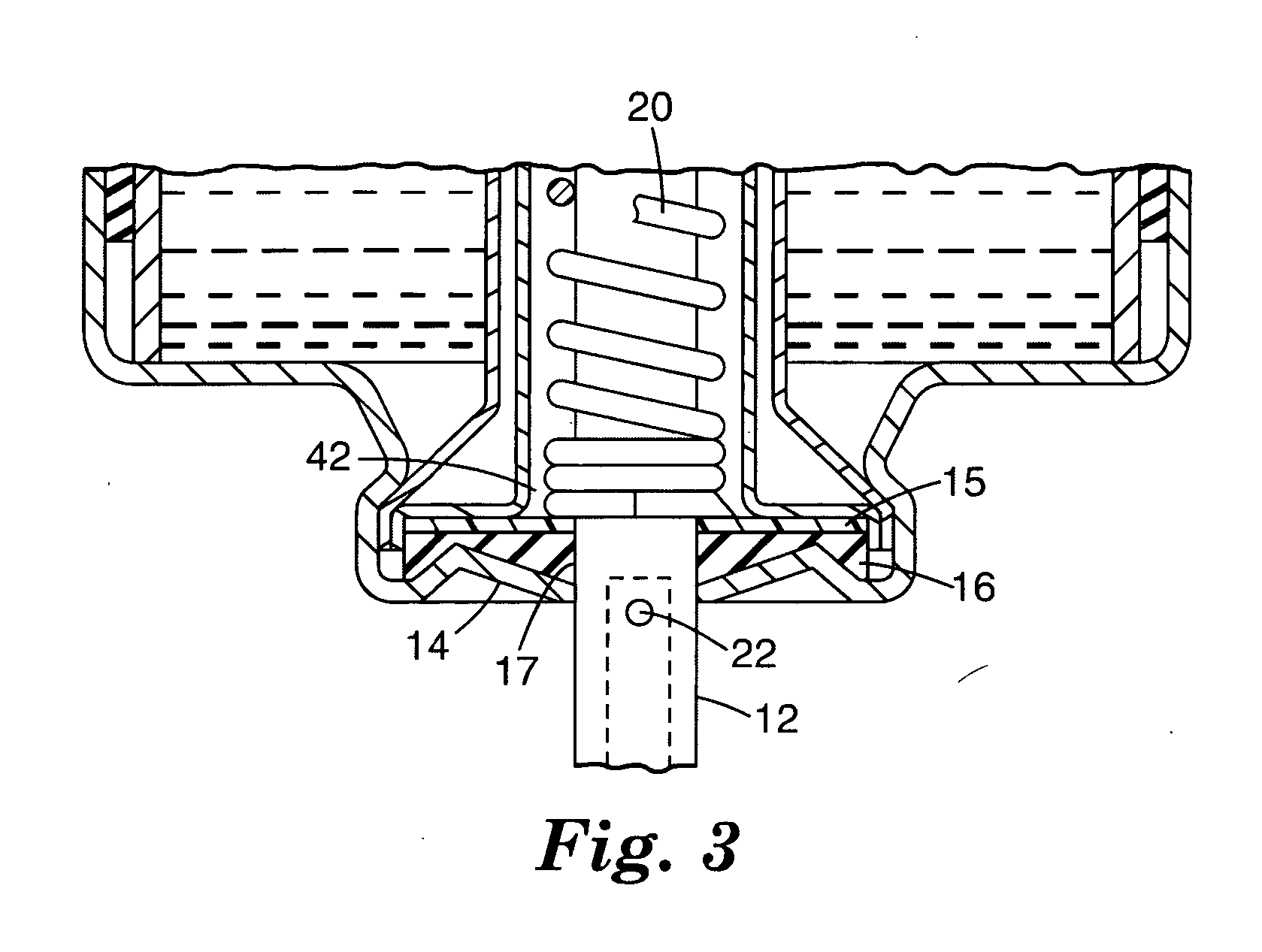Diaphragm seal for use in a medicinal aerosol
a technology of diaphragm and aerosol, which is applied in the direction of liquid transfer devices, combustion types, lighting and heating apparatus, etc., can solve the problems of limiting the shelf life of medicinal aerosol, and achieve the effect of tight sealing and avoiding long-term compression s
- Summary
- Abstract
- Description
- Claims
- Application Information
AI Technical Summary
Benefits of technology
Problems solved by technology
Method used
Image
Examples
example 1
[0034] 15-mL aluminum aerosol vials were each cold filled with approximately 9 g of a 90 / 10 (w / w) HFA-134A and ethanol mixture. All vials were fitted with 50 μL valves having 0.110 inch (2.79 mm) outer diameter, stainless steel valve stems. An approximately 10 mm outer diameter, approximately 0.1 inch (2.54 mm) inner diameter, 0.015 inch (381 μm) thick layer (shown as 16 in FIG. 3) of ethylene-butene copolymer (Union Carbide DFDB-1085) was placed between the aluminum ferrule and an approximately 8.5 mm outer diameter, 0.097 inch (2.46 mm) inner diameter, 0.038 inch (965 μm) thick layer of nitrile rubber (DB-218, American Gasket and Rubber, Chicago, Ill.) layer (shown as 15 in FIG. 3) during valve assembly. Aerosol devices were placed in a water bath at 55° C. for 3 minutes. After removal from the water bath, 5 shots were fired from each aerosol device. Leakage rates were tested at both ambient and elevated temperature (40° C.) conditions and the results are reported in Table 1. Valv...
example 2
[0035] An aerosol device was prepared as in Example 1, except that the 0.015 inch (381 μm) thick layer of ethylene-butene copolymer (Union Carbide DFDB-1085) had an approximately 8.5 mm outer diameter and an approximately 0.1 inch (2.54 mm) inner diameter. Leakage rates were tested at both ambient and elevated temperature (40° C.) conditions and the results are reported in Table 1. Valve delivery was 60.7 (st. dev.=0.3) mg.
example 3
[0036] 15-mL aluminum aerosol vials were each cold filled with approximately 9 g of a 90 / 10 (w / w) HFA-134A and ethanol mixture. All vials were fitted with 50 μL valves having 0.110 inch (2.79 mm) outer diameter, stainless steel valve stems. An approximately 8.5 mm outer diameter, 0.09 inch (2.29 mm) inner diameter, 0.050 inch (1.27 mm) thick layer (shown as 16 in FIG. 3) of ethylene-butene copolymer (Union Carbide DFDB-1085) was placed between the aluminum ferrule and an approximately 8 mm outer diameter, 0.1 inch inner diameter, 0.017 inch (432 μm) thick layer of nitrile rubber (DB-218, American Gasket and Rubber, Chicago, Ill.) layer (shown as 15 in FIG. 3) during valve assembly. Aerosol devices were placed in a water bath at 55° C. for 3 minutes. After removal from the water bath, 5 shots were fired from each aerosol device. Leakage rates were tested at both ambient and elevated temperature (40° C.) conditions and the results are reported in Table 1. Valve delivery was 59.5 (st. ...
PUM
 Login to View More
Login to View More Abstract
Description
Claims
Application Information
 Login to View More
Login to View More - R&D
- Intellectual Property
- Life Sciences
- Materials
- Tech Scout
- Unparalleled Data Quality
- Higher Quality Content
- 60% Fewer Hallucinations
Browse by: Latest US Patents, China's latest patents, Technical Efficacy Thesaurus, Application Domain, Technology Topic, Popular Technical Reports.
© 2025 PatSnap. All rights reserved.Legal|Privacy policy|Modern Slavery Act Transparency Statement|Sitemap|About US| Contact US: help@patsnap.com



